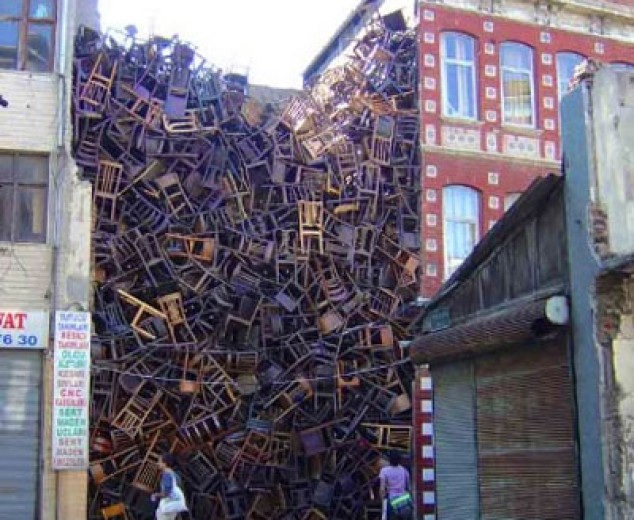Quando lo spazio in cantina non basta più!!
Potrebbe sembrare che le cantine dei condominii adiacenti siano esplose, in realtà l’enorme cumulo di sedie è l’opera 1550 Chairs Stacked Between Buildings, presentata dall’artista Doris Salcedo (Bogotà, 1958) alla Biennale di Istanbul del 2003.
Le 1550 sedie di legno accatastate tra due edifici su di un terreno edificabile evocano le masse di immigrati senza volto sui quali si fonda la nostra economia globalizzata .
Negli ultimi anni Salcedo ha sempre affrontato nei suoi lavori il tema la forza distruttiva della violenza, i traumi personali e collettivi e la tragedia della perdita umana .
In questo lavoro Salcedo concentra l’attenzione sulle silenziose vite degli emarginati, sull’esperienza di persone del Terzo Mondo che entrano nel cuore dell’Europa, divenendo parte integrante di un sistema del quale non restano inesorabilmente vittime.
La potenza dei lavori di Salcedo sta nel rendere visibile l’assenza, l’oppressione e il divario tra gli emarginati e il Potere, trasformando oggetti familiari in metafore visive.
When the basement space is not enough!!
It might look like the basements of neighboring condominiums exploded; actually, this huge pile of chairs is the work 1550 Chairs Stacked Between Buildings, presented by artist Doris Salcedo (Bogotá, 1958) at the Istanbul Biennial in 2003.
1550 wooden chairs are stacked up one another within two buildings on a residential zoning and recall the masses of immigrants who have no face, though constitute the foundations of our globalized economy.
During the past few years, Salcedo’s works have always been dealing with the theme of violence and its destructive power, personal and collective traumas and the tragedy of human loss.
In this work Salcedo focuses his attention on marginalized people’s quiet lives, on the experiences of people coming from the Third World and entering central Europe to become integral part of a system which inexorably victimizes them.
The power of Salcedo’s works lies in his rendering absence visible, the oppression and gap between marginalized people and Power, turning familiar objects into visual metaphors.

